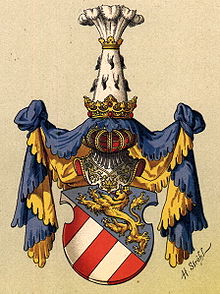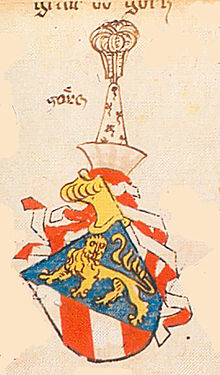- Meinhardiner
-
House of Meinhardin  Gorizia County coat of arms, Hugo Gerhard Ströhl, 1890
Gorizia County coat of arms, Hugo Gerhard Ströhl, 1890
Country Austria Ancestral house House of Siegharding Titles
King of Bohemia and Polen
Duke of Carinthia
Margrave of Istria and Moravia
Count of Gorizia and Tyrol etcFounder Count Meginhard of Pustertal Final sovereign Leonhard of Gorizia Founding 11th century Deposition 1500 The Meinhardiner or Counts of Görz/Gorizia (German: Grafen von Görz; Italian: Conti di Gorizia) were a comital dynasty in the Holy Roman Empire, originally officials in the Patriarchate of Aquileia, who from 1127 ruled the County of Görz (Gorizia). In 1253 they inherited the County of Tyrol, which passed to the cadet branch of Gorizia-Tyrol in 1271, also Dukes of Carinthia from 1286 onwards. Henry of Gorizia-Tyrol by marriage even assumed the rule over the Kingdom of Bohemia and (titular) the Kingdom of Poland in 1306 and again from 1307 to 1310. However, as he left no male heirs, the Gorizia-Tyrol branch became extinct upon the death of his daughter Margaret in 1369. The line of the Counts of Görz died out in 1500, all Meinhardiner estates were finally incorporated by the Austrian House of Habsburg.
Contents
History
The dynasty probably hailed from the Rhenish Franconian Siegharding dynasty, which originally descended from the Kraichgau region and in the 10th century ruled in the Chiemgau of the German stem duchy of Bavaria. One Siegharding Meginhard (or Meinhard, d. 1090) is documented as a count in the Tyrolean Puster Valley. The progenitor of the Meinhardiner, Count Meinhard I of Gorizia, and his brother Engelbert, Count palatine of Bavaria, may be his sons. The dynasty first appeared around Lienz and gained the office of a vogt at the town of Gorizia (Görz) in the Patriarchate of Aquileia in the 11th century.
The Country of Tyrolia was already in the early and later Middle Ages an important mountain pass area with the lowermost crossings over the Central Eastern Alps, vital for the Holy Roman Emperors to reach the Kingdom of Italy. The centers of the Imperial power were initially two Prince-bishoprics established by Emperor Conrad II in 1027, Brixen (Bressanone) and Trient (Trento). The bishops were the sovereigns of many semi-free compulsory henchmen (Ministerials) and base noblemen which styled until today the scenery with their numerous castles mostly south of the Brenner Pass. One of that noblemen families were the Counts of Tyrol, named by the Castle Tyrol near the town of Meran. They speedily ascended as bailiffs which exercised the judiicial power for the Trient and Brixen bishops and finally took over the secular power in the southern Duchy of Bavaria after the deposition of the Welf duke Henry the Lion in 1180. That fact is also to comprehend by seeing that the name of the ancestral mension was finally transferred over the whole country.
Between 1253 and 1258 the Counts of Görz assumed the power in Tyrol after the Counts of Tyrol vanished in the virile succession. In 1237 Count Meinhard III of Gorizia had married Adelheid, daughter of Count Albert III of Tyrol who died in 1253 leaving no male heirs, and could in this way demand his inheritance-claims. His son and successor Count Meinhard IV build up not only his rule, but could also urge on the building of a passably homogeneous country not only by the erection of a for then circumstances really exemplary administration. Anyhow the three areas of reign were to large for only one sovereign and primary to much distant, so was initiated a sharing out in 1267/71, whereby Meinhard IV ceded the County of Görz to his younger brother Albert I. Albert's descendants, the so-called Görz Meinhardins, maintained until their extinction in the year 1500 the ancestral mansion at Gorizia, while the descendants of Meinhard IV (Count Meinhard II of Tyrol) ruled to their vanish in the virile succession over Tyrol.
In 1286 Meinhard IV received the rule over the Duchy of Carinthia and the adjacent March of Carniola by King Rudolph I of Germany in turn for his support against King Ottokar II of Bohemia. His son Henry in 1306 married Anne, the eldest daughter of King Wenceslaus II of Bohemia and after the sudden death of her brother King Wenceslaus III in the same year even ascended the Bohemian throne. He however had to deal with claims raised by the Habsburg scion Rudolph III, son of King Albert I of Germany, and in the long run both could not prevail against Count John of Luxembourg, who became Bohemian king in 1310. As Henry himself left no male heirs upon his death in 1335, the Austrian House of Habsburg earned the legacy of the Görz-Tyrol branch in Carinthia and Carniola, which they held until 1918. Henry's only surviving daughter Margaret "Maultasch" and her husband John Henry of Luxembourg were only able to retain the County of Tyrol. In 1363 she ceded the county also to the Habsburg duke Rudolph IV of Austria after her only son with her second husband Duke Louis V of Bavaria, Count Meinhard III of Gorizia-Tyrol had died in the same year.
The Counts of Görz were moreover the Bailiffs of Aquileja. They are famous in numismatics as publishers of the first German golden coin, the "Zwainziger". The renowned diplomat and minnesinger Oswald von Wolkenstein was a subordinate of the Counts of Görz. The Gorizia branch of the dynasty became extinct in the year 1500, when the last male family member Count Leonhard of Gorizia died withoud issue. One apparent or illegitimate branch of the Meinhardiner was the Graben von Stein family. After Leonhards of Gorizias death they became his succeeder as stadtholders at Lienz in East Tyrol.
Counts of Görz
- Marquard (fl. 1060/1074), Vogt of Aquileia
- Henry I (died after 1102), Vogt of Aquileia from 1082
- Ulrich (died 1122), brother
- Meginhard (died about 1090), from the House of Siegharding, Count in the Puster Valley
- Meinhard I (died 1139/1142), descendance uncertain, mentioned as Count of Görz in 1117, jointly with his brother
- Engelbert I (died about 1122), also Count palatine of Bavaria and Vogt of Millstatt Abbey in Carinthia
- Engelbert II (1142–1191), son of Meinhard I, jointly with his brother
- Henry II (1142–1150)
- Engelbert III (1191–1220), son of Engelbert II, jointly with his brother
- Meinhard II the Old (1191–1231)
- Meinhard III (1231–1258), son of Engelbert III, inherited Tyrol in 1253
Görz-Tyrol
- Meinhard IV (1258–1271), Count of Tyrol after partition, also Duke of Carinthia from 1286 until 1295
- Henry V, son of Meinhard IV, Count of Tyrol and Duke of Carinthia from 1295, King of Bohemia 1306 and 1307-1310
- Margaret, Countess of Tyrol (1335-1363), daughter of Henry V
Line extinct, Tyrol fell to House of Habsburg
Görz
- Albert I (1258–1304), until 1271 jointly with his brother Meinhard IV
- Albert II (1304–1325), son of Albert I, jointly with his brother
- Henry III (1304–1323) until 1307 partition, succeeded by
- John Henry (1323–1338), son of Henry III
- Meinhard VI (1338-1385), son of Albert II, Princely Count from 1365, and his brothers
- Albert III (1338–1374)
- Henry IV (1338–1362)
- Henry VI (1385–1454), son of Meinhard VI, jointly with his brother
- John Meinhard (1385–1429)
- Leonhard (1454–1500), son of Henry VI, jointly with his brothers
- John (1454–1462)
- Louis (1454–after 1456)
Possessions to House of Habsburg, Gorizia part of Inner Austria from 1564 to 1619, Lienz unified with Tyrol
Other family members
- Elisabeth of Gorizia-Tyrol (1262–1312), daughter of Meinhard IV, Queen-consort of the Romans in 1298 by marriage with King Albert I of Germany
- Elisabeth of Carinthia (1298 – after 1347), her niece, granddaughter of Meinhard IV by his son Otto, in 1337 queen-consort of Sicily as wife of King Peter II of Sicily
- Meinhard V, (died after 1318), son of Henry III
Categories:- Austrian noble families
- Royal families
- Meinhardiner
- Counts of Gorizia
Wikimedia Foundation. 2010.

